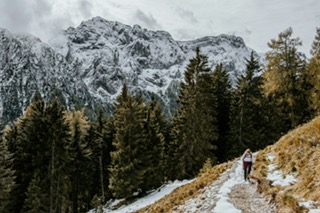Disclaimer: This article may contain affiliate links. When you click these links, I may get a small commission. It won’t cost you anything but helps me run this site. I only promote products that I think are great.
Hiking is a great way to reduce stress and exercise your body. If you are a beginner hiker and aren’t sure what all you need to get started with hiking, here is a guide for the basics of what you should wear, what you should bring, and what you should know before heading out.
What To Wear
Hiking Shoes
We prefer to wear trail running shoes on our hikes. They are lightweight and provide high traction and grip. My favorite trail running shoes are Saucony.
Base Layer
Avoid cotton materials. You should stick with a moisture wicking tee or tank in warmer weather. If you are hiking in colder weather, you will want your base layer to be made of merino wool.
Outer Layers
In the summer, a lightweight merino wool zip up will provide some warmth in the chillier morning hours. In the spring and fall a fleece pullover will provide some extra warmth.
Socks
Once again merino wool should be your go to when choosing socks for hiking. The quick drying material will save your feet from blisters. I highly recommend Darn Tough socks. They are a little pricey but worth the extra money because they come with a lifetime guarantee.
What To Bring

Day Pack
You are going to want to make sure you have a comfortable day pack. Nothing can ruin a gorgeous hike faster than a pack cutting into your shoulders or chafing your sides. Our favorite pack is the Osprey 9. It comes equipped with stow on the go trekking pole attachment, hip belt pockets, front panel bungee, and water bottle pockets.
Water
You should bring 16 ounces of water for every hour that you will be hiking. We prefer to use water bottles. Our go to is Hydro Flask. Some people prefer to use hydration bladders. These usually hold 2 – 3 liters of water.
First Aid Kit
Always, always, always carry a first aid kit with you while out hiking. We have used ours several times for scrapes and blisters. You just never know when you may need some minor medical attention.
Sunscreen & Bug Spray
Make sure you are protecting your skin while out on your hike. Also, a sunburn can turn a hike miserable real fast. We love Neutrogena Ultra Sheer. It is non-greasy and water resistant, so your skin doesn’t feel tacky, and you don’t have to worry about sweating it off quickly. Depending on where you are hiking, bug spray may not be a necessity. In Pennsylvania, it is a definite for late spring through early fall. We use OFF Botanicals. It is plant based and does not have DEET which can ruin your hiking gear.
Snacks
Snacks on snacks on snacks!! Your body will burn a ton of calories while hiking. Make sure you properly fuel up so that you don’t burn out before your hike is completed. Check out our article on Snacks for our top picks.
Rain Gear
Always pack an extra layer. You never know when a storm can pop up. It’s better to be prepared then left cold and wet. A fleece or light rain jacket will do the trick.
Headlamp
You may find yourself in a situation where the time has gotten away from you. Having a good headlamp with you will make a world of difference if you find yourself in this situation.
Trekking Poles
These are a lifesaver when navigation up and down the mountains. Trekking poles will save your knees and joints by taking off the pressure. They also help when crossing other tricky terrains like streams or rocky areas.
Kula Cloth
It will not fail that eventually you will need to pee while out in the woods. The Kula Cloth will be your best friend when you do! It is made of antimicrobial fabric. And it easily snaps on to the outside of your pack. The waterproof side will keep your hand dry. When you are done just snap it back up and continue on your way.
What To Know
- Check the weather. Make sure that you are dressed appropriately for your hike
- Check AllTrails. AllTrails is a great tool for hiking. It includes mileage, elevation gain, difficulty level, photos, and reviews of trails in the area. It also provides coordinates of the trailheads so you can easily navigate to them.
- Leave No Trace. Learn the basics of the Leave No Trace principles, so that we can preserve our trails and so that others can also enjoy them long after us.
Good luck on your first hike! I hope you enjoy the peacefulness and solitude of nature as much as we do!



